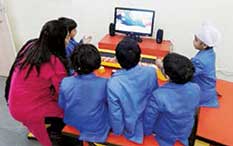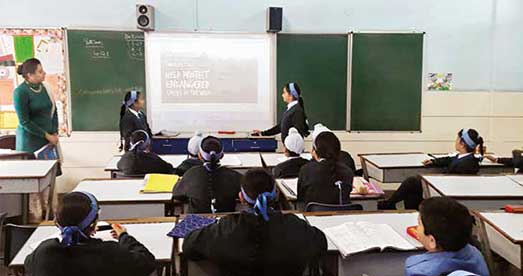Monica Joshi
Teacher, Head of ICT
Kovleen Middha
Teacher
Grade: 4–12
Subject: All subjects
Location: Ludhiana, Punjab
School type: High-income private
Introduction
Monica Joshi works as the Head of IT at a senior secondary ICSE co-educational school in Ludhiana, Punjab in the north of India. The school is run by a private organisation. This case study provides a good example of how some well-equipped, usually private schools in India are making use of technology across the curriculum and to support school management.
Why technology is being used
A key focus in this school is enhancing the essential skill sets demanded in the 21st century – communication, collaboration, creativity, media literacy, global connectedness, critical thinking and problem solving. The school believes that the integration of ICT can play a significant role in developing these skills.
How it works
At this school, technology plays a vital role in academic and administrative functions and, it is argued, makes life easier for both students and teachers. The classrooms are equipped with technology aids including smart boards and the teachers have access to materials created for the Extramarks smart class system. The integration of technology has significantly helped in providing access to curricular materials, which can also assess and monitor the learning levels of the students. It has also helped both the teachers and students to experience and, it is suggested, be more accepting of international culture and different views in the world.
Monica highlights that the school aims to strategically plan and support initiatives to become a ‘future-ready school’ by effectively implementing a policy of Bring Your Own Device (BYOD) and by developing appropriate pedagogical techniques for digital learning. The school provides a Massive Open Social Learning (MOSL) environment to help the students interact online in productive discussions and create shared projects to share experience and build ideas into knowledge. The school is also beginning to use Google Apps for Education (GAFE) and other cloud- based technologies. The initiatives aim to make the teaching and learning process more efficient by also improving the flow of communication and information for all the people involved.
Kovleen uses ICT for the following activities:
• preparing digitised curriculum and lesson plans
• preparation of timetables
• generating results and report cards – these are then made available to parents online
• taking student attendance
• basic day-to-day teaching
• setting up holiday homework
• sending circulars to parents
• evaluation of topics through Google forms.
Challenges
Not all of this was easy to achieve even in a well-resourced school. The school needed to make a significant upgrade to their systems in order to install the Enterprise Resource Planning system, including their web server. Parents also needed to be encouraged to engage in the process through meetings and workshops. Tools that were brought in off the shelf had to be customised to suit the requirements and needs of the school. There was a lot of work integrating web links and online sites into the existing lesson plans and the project took considerable management to make it work. It was not just teachers and parents that needed support, the administrative team needed to be given extra help and training too.
 Monica’s comment
Monica’s comment
‘The introduction of technology in the classroom has brought a plethora of positive impacts to educational instruction. The teacher has become more of a facilitator than just a dispenser of information. With the use of technology the students enjoy the topic taught, learn better, understand better and show better performance.’
Examples of digital resources used within the school:
- Flipped teaching with the help of Smartclass Class Transformation System in sync with Extra marks, Mimio tools, Peoples Link and online collaboration with Khan Academy for maths, National Geographic for geography and Wordsworth for English.
- Jaws software helps children with special needs by enabling them to access digital resources using audio-visual aids.
- Teachers upload content through the cloud-based ecosystem and the Enterprise Resource Planning system, which can be accessed by students and parents for tasks such as homework and schedules. Parents can monitor academic performance through graphical presentation and progress reports.
- Digitised lesson plans and curriculum mapping templates are provided to support teachers’ planning and improve pedagogical practices.
- Online collaboration with international schools to enhance global understanding and CISCO web links to learn foreign languages.
Kovleen’s view
Kovleen Middha is a teacher of science at the school. She uses a range of different technologies to support the development of classroom learning. She says, ‘I use webpages, research projects, videos, Microsoft Office tools and Google tools to enhance teaching of a concept, thus demonstrating that technology can be used to complement other aspects of good teaching rather than replace them. I try to work towards a student-centric pedagogy where technology is used effectively to create optimal learning experiences … With ICT, I am able to create my own material and thus have more control over the material used in the classroom.’
To find out more
• http://www.extramarks.com/smart-learn-classroom
• http://www.mimio.com/en-EM/Products/MimioStudio-Software.aspx
• https://www.khanacademy.org
• https://www.wordsworthlearning.com
• http://nationalgeographic.org/education/?ar_a=1
• https://www.google.com/edu/products/productivity-tools
This is an excerpt from Teaching and technology: Case studies from India, edited by Gary Motteram and reproduced with permission from Central Square Foundation and British Council India. The full publication with many more case studies can be found here: http://centralsquarefoundation.org/research/teaching-technology-case-studies-india/

